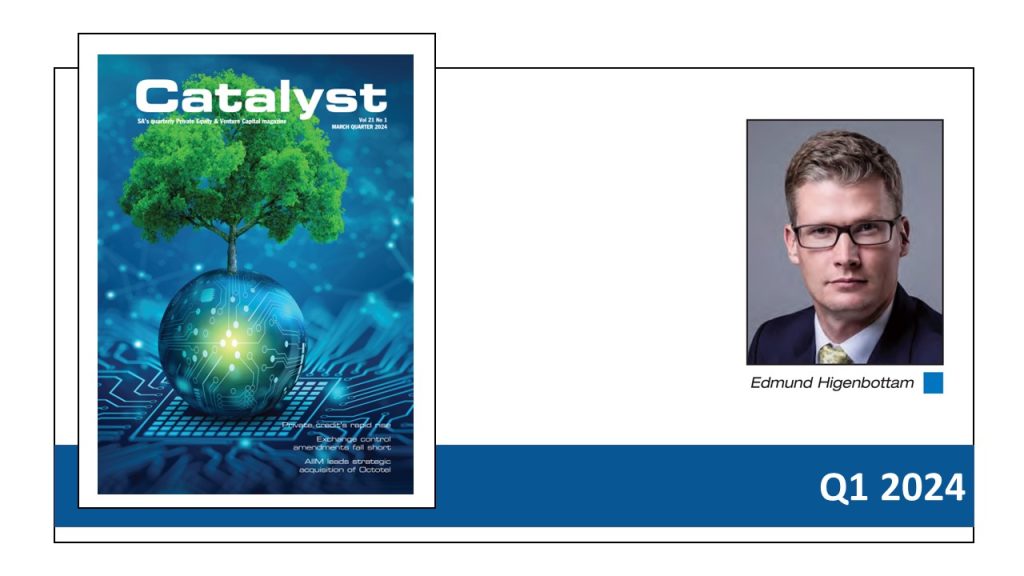The market for private credit or private debt has ballooned in recent years, and Catalyst caught up with Edmund Higenbottam, principal at Verdant Capital, to find out what’s driving this, and whether that balloon is at risk of popping.
Verdant Capital is a leading investment bank and investment manager, operating on a pan-African basis and specialising in private capital markets. It boasts offices in Johannesburg, Ebene, Accra, Harare, Kinshasa and Frankfurt, and Higenbottam was instrumental in establishing its hybrid fund.
“It’s a fund of about US$40 million or R800 million, and we invest sectorally, in financial services, alternative credit and digital finance, with a broad mandate in terms of the investment types that we make,” explains Higenbottam.
“In terms of the investment sizes, we do junior debt with credit enhancements, all the way through to structures which are preferred equity or senior equity.”
In recent years, a quiet transformation has been reshaping the private equity industry. This change is led by the robust growth of private credit, an asset class that, until recently, was overshadowed by more traditional forms of credit, such as bank loans and public bonds. Today, the market for private credit in the United States has swelled to rival the size of the publicly-traded, junk-rated corporate bond market, reaching an estimated $1,3 to $1,6 trillion.
Private credit refers to debt that is privately originated and is not traded on any public market. This financing option encompasses a variety of debt types, including direct lending, opportunistic debt, distressed debt, and real estate financing. It typically involves loans that are not mediated by banks and are often unrated by major credit rating agencies.
Private credit presents a different appeal to both borrowers and investors. For borrowers – especially those backed by private equity firms – private credit offers certainty of execution, less complexity in deal structuring, and a relationship-driven approach that allows for more bespoke financing solutions.
Until recently, private credit and mezzanine debt was a niche asset class globally.
“It’s almost like the unsexy bit of private equity,” reckons Higenbottam, “and the Barbarians at the Gate, where the big buyout shops had all the glory and all the reward; but I think that’s actually changed.”
Higenbottam sheds light on why this market segment has not only survived, but thrived, even amidst rising interest rates – a scenario that traditionally signals caution for credit markets.
According to Higenbottam, the resilience of private credit can be attributed to its structural advantages over syndicated markets. The personalised, relationship-based nature of private credit deals provides more direct communication and flexibility between lenders and borrowers. This setup often leads to better outcomes in terms of default rates and recovery rates during economic downturns, as was evident during the COVID-19 pandemic.
“15 years ago, private credit was just mezzanine. But now we see a variety of different strategies sectorally, also in terms of layers in the capital stack. The big asset class in private credit today is senior and stretch seniors, not mezzanine anymore. And that, in itself, is very interesting. To some extent, that’s the funds competing with the banks.”
Higenbottam touches on one of the main drivers of this tectonic shift in private equity markets: changes in bank regulation.
Largely, the air inflating the ballooning private credit market has been by design of the regulators. Post the 2008 global financial crisis, regulators wanted to squeeze out a lot of the riskier stuff from the banks’ capital structures and into the so-called shadow banking market, which includes things like Business Development Companies (BDCs) and private credit funds.
BDCs are publicly traded entities, focused on lending to and investing in private businesses. Established to promote investment in small and mid-sized firms, BDCs open doors to private credit markets. A standout advantage of BDCs is their inherent liquidity. Unlike traditional private credit funds, which often have multi-year lockup periods, BDCs are listed on major stock exchanges and can be traded daily. This grants investors the ability to modify their positions in response to market changes, personal financial needs, or altered investment tactics.
The surprising thing, to some extent, is that private credit has continued to grow, even as interest rates have surged, defying many people’s expectation that this nascent market would suffer once the era of “loose” money came to an end. Instead, the market for private credit in the US now rivals the size of the market for publicly-traded, junk-rated corporate bonds.
Higenbottam believes that the regulators have been correct in forcing this sort of credit extension into the hands of private investors and away from banks, who are responsible to depositors as much as shareholders.
“I do think that there are massive societal issues of deposit-taking institutions with implicit sovereign guarantees playing in risky asset classes, and we saw that in the great crash in 2007, 2008. We’re living in a world today where regulation of deposit money banks in the US and in Western Europe is relatively tight, and so it should be.”
In Africa, specifically, private credit has grown while the rest of the asset class has contracted, and Higenbottam believes it’s because private credit has developed a track record as a higher return asset class than equity funds, with less volatility between the vintages, less variance between the managers, and less volatility around tenor.
“And that’s also been an issue in private equity in Africa; it’s not just returns, and [returns] being perhaps a little bit underwhelming… there’s been term extension, there’s been limited control over tenor, so private credit has grown,” explains Higenbottam.
He concedes that private credit globally has moderated with rising interest rates.
“We see that with some of the firms’ funds with a global mandate or global emerging market or a global south mandate, we’ve seen liquidity in some of those, particularly the senior funds, become less liquid. We’ve seen little outflows, whereas in the last few years, they’ve had big inflows.”
For investors, private credit offers attractive yields and a diversification option that is less correlated with broader market fluctuations. These investments are typically structured with floating rates, providing a hedge against rising interest rates, while delivering consistent income. Additionally, the illiquid nature of these loans commands a premium, albeit at the cost of reduced liquidity.
However, the illiquidity of private credit also contributes to its stability. Since these assets are not marked-to-market as frequently as publicly traded securities, they do not exhibit the same volatility, providing a buffer during market dips, but also masking potential underperformance until a financial distress event occurs.
As banks respond to the competitive threat posed by private credit, some have begun to establish their own direct lending platforms. Nonetheless, the direct lending market is expected to continue expanding, driven by the ongoing need for refinancing as large volumes of syndicated loans reach maturity.
There is a rumbling in the market that, globally, regulators might start to take a closer look at the private debt market and this regulatory arbitrage question between the banks and private credit. But despite potential regulatory scrutiny as the market grows, the fundamentally conservative structure of many private credit investments – like those structured within (BDCs) – places them on a more stable footing. BDCs, for instance, are limited in how much leverage they can incur, offering a built-in protection against over-leveraging.
While some believe that the balloon doesn’t appear to be in danger of popping any time soon, driven by its ability to offer reliable returns and structural advantages that benefit both borrowers and lenders, worrying signs lurk on the horizon, especially in the US.
Currently, corporate interest costs as a percentage of net income are just 9.1%, the lowest since 1956. By comparison, this percentage was as high as 60% during the Global Financial Crisis.
Why is it so low right now?
Most businesses have locked in debt at fixed rates, making them temporarily immune to rising interest rates. However, over US$1 trillion of debt is maturing within the next 12 months, which will be refinanced at much higher rates. Therefore, businesses will soon feel the pain of higher rates.
As the market continues to mature and evolve, private credit faces its sternest challenge yet.
Michael Avery, is the editor of Catalyst

This article first appeared in Catalyst, DealMakers’ quarterly private equity publication.
DealMakers is SA’s M&A publication.
www.dealmakerssouthafrica.com



